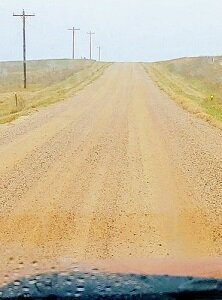One thing I’ve learned in my short time in South Dakota is that things are defined differently here than back east in New York State.
I learned that lesson most pointedly during my 186-mile drive from the state capital of Pierre, located in the center of South Dakota, to Deadwood, set on the western-most border.
For the most part, the landscape along my drive was rural and open, dotted occasionally with round bales of hay, metal storage bins and cattle in the far off distance. It was only after a scenic detour that my vista changed.
After encouragment from people I’d met during my trip, I decided to break up my highway journey by taking the driving loop through the Badlands. This is a world-renown national park comprised of canyons, ravines, gullies, mesas, hoodoos and other such geologic forms that have been formed and shaped by hundreds of years of eroding winds and rains. As it turned out, it was a hauntingly beautiful experience.
As I exited the Badlands, my truck’s GPS directed me along some roads far removed from the main Route 90 Highway. So far off, in fact, that I eventually found myself driving on a dirt road.
Now, as background, I am the daughter of farm woman, the granddaughter of a farm family from Wyoming County, NY. Dirt roads are nothing new to me. In fact, I was almost a teenager before my grandparent’s Curriers Road was earmarked for paving
Along with those dirt roads came my family’s farm tradition of crossing the cows. As implied, farmers often owned land on both sides of the road. To preserve the nutritional value of their pastures they would move their herd from one side to the other on a regular basis.
This process involved the farmer opening the pasture gates on both sides of the road and prodding and pushing the cows until the very last one crossed. In actuality, there were usually one or two leaders in the herd and where ever they went, the rest followed. So, after a few times, a “follow the leader” crossing process became pretty routine.
And that’s what ran through my mind as I got about two miles down this South Dakota dirt road and saw a cautionary “cow crossing” sign.
It was less than a mile before I saw a herd of black cows in the distance. However, no matter how hard I strained my eyes, there were a few things missing----like a farmer and some fences.
The closer I got to the oversized bovines the more I realized that in South Dakota, a cow crossing sign meant just that. Cows could be independently crossing the road at any time!
Like I said. I come from a family of farmers and traditionally would not be overly concerned about driving alongside some cows. However, I’d just spent five days motoring through national parks where the constant warning was to respect the animals that roam freely across their roads, or suffer the ravages of a damaged car….or worse!
Deciding to err on the side of caution, I stopped a good distance from the cows who were meandering from pasture to dirt road to pasture. Sometimes they went backwards, sometimes forwards, always at a pace that clearly indicated they had no concern about my presence in their rural landscape.
Finally it got to where there were only two cows left in the road. To be honest it almost seemed as if they were purposely toying with me to see just how long it would be before I tried to make a break and speed by them.
As the last of the herd took steps onto the green grass pasture, I slowly started inching past them, keeping a wary eye to ensure that none of them might decide to take dead aim at me and my red rental truck.
As it turned out, not a moo was mooed, not a charge was mounted. And I as cleared that last cow, we stared at each other for a long moment in which I breathed a deep sigh of relief…..by any definition of the term.




